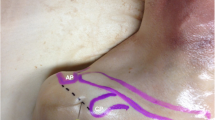Abstract
Degeneration of the acromioclavicular joint (AC) often causes impaired shoulder function and pain. Its infiltration results in reportedly beneficial short-term effects. Misplacement of infiltrations is observed in high numbers. A previous study showed high accuracy of infiltrations of one surgeon comparing conventional palpation technique to ultrasound guidance. This study evaluates if ultrasound-guided AC joint infiltration is feasible for therapists of different levels of experience and if the accuracy can be increased. One hundred and twenty AC joints of 60 cadavers were enrolled into a prospective, randomized observer-blinded study. Six therapists of three different levels of experience infiltrated 20 AC joints each. Half of them were infiltrated after palpation of the joint space, half of them were ultrasound-guided infiltrated. Controls were performed pre- and post-infiltration by an independent radiologist. In total, accurate infiltration was observed in 70%. In 25%, misplacement of the infiltration was recorded in the palpation-, in 2% in the ultrasound- and in 3% in both groups. The difference between the two groups was significant (P = 0.009). Ultrasound-guided infiltration to the AC joint is significantly more accurate than conventional palpation technique. This method is simple, efficient and can be applied by therapists of all levels of experience.


Similar content being viewed by others
References
Bain GI, van Riet RP, Gooi C, Ashwood N (2007) The long-term efficacy of corticosteroid injection into the acromioclavicular joint using a dynamic fluoroscopic method. Int J Should Surg 1:104–107
Bisbinas I, Belthur M, Said HG, Green M, Learmonth DJ (2006) Accuracy of needle placement in AC joint injections. Knee Surg Sports Traumatol Arthrosc 14:762–765
Cunnington J, Marshall N, Hide G, Bracewell C, Isaacs J, Platt P, Kane D (2010) A randomised, controlled, double blinded study of ultrasound guided corticosteroid joint injection in patients with inflammatory arthritis. Arthritis Rheum. doi:10.1002/art.27448
Del Cura JL (2008) Ultrasound-guided therapeutic procedures in the musculoskeletal system. Curr Probl Diagn Radiol 37:203–218
Fialka C, Krestan CR, Stampfl P, Trieb K, Aharinejad S, Vecsei V (2005) Visualization of intraarticular structures of the acromioclavicular joint in an ex vivo model using a dedicated MRI protocol. Am J Roentgenol 185:1126–1131
Gokalp G, Dusak A, Yazici Z (2010) Efficacy of ultrasonography-guided shoulder MR arthrography using a posterior approach. Skeletal Radiol 39:575–579
Heers G, Hedtmann A (2005) Correlation of ultrasonographic findings to Tossy’s and Rockwood’s classification of acromioclavicular joint injuries. Ultrasound Med Biol 31:725–732
Hiemstra LA, MacDonald PB, Froese W (2003) Subacromial infection following corticosteroid injection. J Should Elbow Surg 12:91–93
Jacob AK, Sallay PI (1997) Therapeutic efficacy of corticosteroid injections in the acromioclavicular joint. Biomed Sci Instrum 34:380–385
Mazzocca RA, Arciero RA, Bicos J (2007) Clinical sports medicine update: evaluation and treatment of acromioclavicular joint injuries. Am J Sports Med 35:316–329
Raza K, Lee CY, Pilling D, Heaton S, Situnayake RD, Carruthers DM, Buckley CD, Gordon C, Salmon M (2003) Ultrasound guidance allows accurate needle placement and aspiration from small joints in patients with early inflammatory arthritis. Rheumatology 42:976–979
Rutten MJ, Collins JM, Maresch BJ, Smeets JH, Janssen CM, Kiemeney LA, Jager GJ (2009) Glenohumeral joint injection: a comparative study of ultrasound and fluoroscopically guided techniques before MR arthrography. Eur Radiol 19:722–730
Sabeti-Aschraf M, Ochsner A, Schueller-Weidekamm C, Schmidt M, Funovics PT, v Skrbensky G, Goll A, Schatz KD (2009) The infiltration of the AC joint: ultrasound versus palpation: a prospective randomized pilot study. Eur J Rad PMID. 19647964
Shaffer BS (1997) Conditions of the acromioclavicular joint. J Am Acad Orthop Surg 7:176–188
Author information
Authors and Affiliations
Corresponding author
Rights and permissions
About this article
Cite this article
Sabeti-Aschraf, M., Lemmerhofer, B., Lang, S. et al. Ultrasound guidance improves the accuracy of the acromioclavicular joint infiltration: a prospective randomized study. Knee Surg Sports Traumatol Arthrosc 19, 292–295 (2011). https://doi.org/10.1007/s00167-010-1197-y
Received:
Accepted:
Published:
Issue Date:
DOI: https://doi.org/10.1007/s00167-010-1197-y




